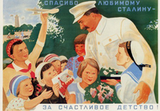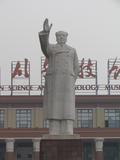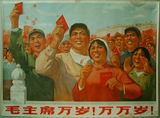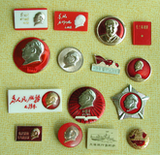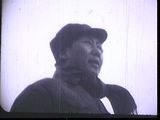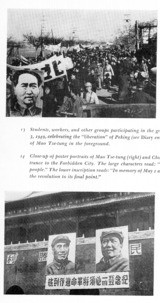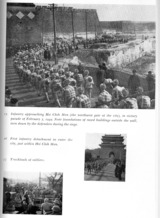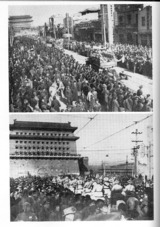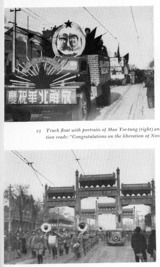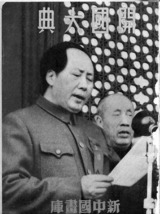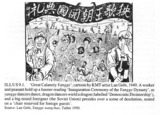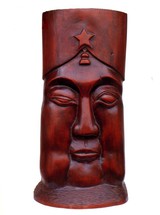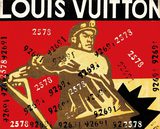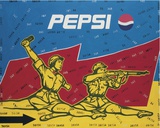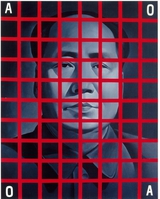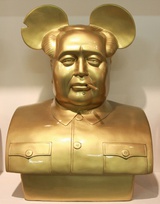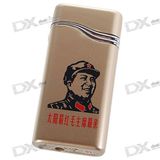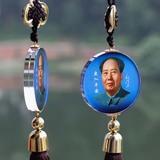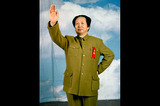First Previous Next Last
Introduction
James A. Cook, Joshua Goldstein, Matthew Johnson, and Sigrid Schmalzer
Images
Figure 1.1
Portrait of Mao Zedong overlooking Tiananmen Square. Diego Delso, Gate of Heavenly Peace, Beijing, China. 2006. Available from: Wikimedia Commons, License CC-BY-SA 3.0 (accessed December 19, 2013).Figure 1.2
The Qianlong Emperor's Entry into Suzhou in 1751, featuring the emperor on horseback surrounded by his most loyal and stalwart Manchu and Mongolian troops. From: Xu Yang, Qianlong nanxun tu juan [Illustrated Scrolls of the Qianlong Emperor’s Southern Tour]. c. 1770. Scroll six detail. Source: The Metropolitan Museum of Art, New York. Used with permission.
Figure 1.3
This full-page photo of the ceremonial internment of Sun Yat-sen’s at his memorial outside Nanjing graced page one of the China’s most cosmopolitan pictorial magazine, the Young Companion in June 1929. The towering grandeur of the monument is highlighted both by the perspective of the photograph and the caption “Under blue skies and brilliant sunshine the Chinese Republic sorrowfully and reverently placed its creator at rest in the magnificent mausoleum at Purple Mountain at noon on June 1.” From: Liangyou Huabao, June 1929.Figure 1.4
Painted wood block of Zhong Kui (auspicious demon slayer) in the form of a door god, produced in Yangliuqing area, Kangxi era. In addition to New Years pictures, Yangliuqing’s artisan produced images of household deities such as door and kitchen gods that were also customarily hung during New Year celebrations. This rendering demonstrates the refined style for which Yangliuqing was so renowned. Artist anonymous. From: Pan Yuanshi and Wang Lixia, Yangliuqing ban hua [Yangliuqing Prints]. Taipei: Xiongshi tushu gufen youliang gongsi, 1975.Figure 1.5
Three female champion swimmers, the He sisters, pose here for the camera. From: Qingdao shi Tiyu xiejinhui, Liang zhounian gongzuo zongbaogao [Two Year Anniversary Official Work Report]. Qingdao: Qingdao Tiyu xiejinhui chuban weiyuanhui, 1935, n.p.Figure 1.6
A shophouse in Xiamen. From: Hong Puren, Xiamen jiu jing [Old Photographs of Xiamen]. Beijing: Renmin meishu chuban she, 1999. Used with permission.Figure 1.7
This still is from footage produced by a Guomindang film company and included in Frank Capra’s famous Why We Fight film series, which was shown in both China and the United States. The image portrays the Chinese as united against the onslaught of Japanese aggression. From: Why We Fight: The Battle for China. Directed by Frank Capra. 1944; Los Angeles, CA: U.S. Army Signal Corps.Figure 1.8
Photograph of a moving-day celebration orchestrated by the Chinese Communist Party in 1946 in the city of Dalian. From: Dalian shi shizhi bangongshi, ed., Dalian shizhi wenhua zhi (Dalian city cultural gazetteer). Dalian: Dalian chubanshe, 2003.Figure 1.9
This photograph, by a photographer of a brigade propaganda team in Yunnan, presents a happy image of sent-down youth laboring in the countryside. Today such images are often used to bolster the idea that former sent-down youth should have “no regrets” about their experiences. From: Personal collection of Xie Guangzhi.Chapter Sample
If a single image could be said to be the icon of modern Chinese history, it would probably be this portrait of Chairman Mao. Mao’s portrait has been reproduced literally hundreds of billions of times: on untold millions of Mao buttons and propaganda posters of the Cultural Revolution (1966-1976); on rearview mirror ornaments, tee-shirts and cigarette lighters; on Chinese currency (his gentle smile graces every bill of legal tender in China today); and, most famously, on Tiananmen Gate in the heart of Beijing, where he surveys the enormous public square beneath and all who pass through it. This portrait of Mao has been charged with so many vital political and cultural meanings that we would be remiss to discuss modern Chinese visual culture without at least giving a respectful nod to his all-but-disembodied head. Travelers from all over China and the world have made sure to get their photos taken beneath Mao’s oversized portrait. The acclaimed author Yu Hua recalls how important that photo op was for him as a teenager during the Cultural Revolution:
I used to have a photograph of myself when I was fifteen, standing in the middle of Tiananmen Square with Mao’s huge portrait visible in the background. It was taken not in Beijing but in the photography studio of our town a thousand miles away. The room in which I was standing cannot have been more than twenty feet wide, and the square was just a theatrical backdrop painted on the wall. When you looked at the photo, you might almost have believed I was really standing in Tiananmen Square—except for the complete absence of people in the acres of space behind me. This photograph crystallized the dreams of my childhood years—and indeed, the dreams of most Chinese children who lived in other places than Beijing. Almost all studios then were equipped with this same tableau of Tiananmen…1
A potent icon indeed, when an image (a photo) of an image (a painted backdrop) of the image (the portrait in Tiananmen) is still powerful enough to “crystallize a dream.”
What was that dream? Chinese people who experienced the political maelstrom of the Cultural Revolution have devoted memoirs, essays, novels, artworks, and films to unraveling the dreams and conflicts of that era, many highlighting the role that Mao played in Chinese peoples’ lives and psyches at the time—not just as a political leader, but as an idea and an image. The portrait that still hangs over Tiananmen today has long outlived that era, but over the ensuing decades it has accrued many new and often contradictory meanings, and Mao’s bust continues to provoke and inspire today, spawning a global-scale cottage industry of Mao-themed art that offers contradictory perspectives on the man, the revolution, and its aftermath. The reader will find dozens of these artworks and other images related to Mao and his iconic Tiananmen portrait (as well as a great deal of scholarly analysis of these images) on the website that accompanies this volume (http://visualizingmodernchina.org).
We live, today, in an intensely visual culture. We learn, communicate, create, and seek leisurely escape through ever-proliferating modes of visual stimulation—TV, film, smart phones, video games, online media, etc. Yet we rarely pause to consider that this experience of “becoming visual” has unfolded very differently throughout the world and thus bears the indelible marks of unique and specific histories. This volume is intended to encourage just such a consideration of the multiple forms and transformations of visual culture in another time and place—China from the Qing empire (1644-1911) through the Republican era (1912-1949) to the People’s Republic of China (1949-present).
The chapters in this volume work explore key moments and themes in China’s modern history through an analysis of visual records. Together, they challenge the common assumption that visual materials are merely ephemeral images that supplement the substance of history. Rather, the study of visual images requires that we think more broadly about visual culture and engage in critical analysis of image-making as a force in shaping historical dynamics. The study of visual culture has arisen fairly recently. Historians usually emphasize written texts over pictures; art historians, on the other hand, tend to elevate “art” over all other forms of media and experience. But throughout history both written texts and works of art have typically had quite limited audiences and functioned in quite limited contexts. Other forms of display and visuality—parades and processions; domestic and public architecture; everyday clothing and decorations; nature, landscape, and its reconfigurations; and (more recently) magazine ads, personal photographs, and internet websites—have had greater impact on a larger range of creators, viewers, and participants. The idea of visual culture encompasses this vast and changing range of visual materials.
Our goal as historians is not only to understand what certain historical images depict, but also to understand the changing ways that images have been produced, distributed, and experienced, as well as the intentions of their creators, the audiences they sought to address or to shape (loyal subjects, conscious citizens, nations, etc.), and the responses they elicited from those audiences. Of course, “image-makers” — be they governments, commercial interests, or individual artisans —rarely leave records of what they meant to convey when commissioning or crafting particular images. Nor is it easy to uncover the conditions under which historical audiences may have encountered images, how they reacted to those images, and what effects images might have produced in their everyday lives. The analysis of historical images requires great care and ingenuity, hence the strong emphasis on methodology in this introduction and the chapters that follow.
While the subjects described in the essays here cover the eighteenth century to the present, visual culture in China is far from a mere three-hundred-years young. For at least two millennia, Chinese emperors used sumptuous court ritual and elaborate visual displays to establish their authority. In China, as elsewhere, political rulers and social elites sought to control symbols, and with them, culture. Moreover, China was historically on the cutting edge in developing printed media, with woodblock printing spreading both texts and images on a large scale from at least the Song dynasty (960-1279), if not earlier. Still, this primarily text-based media reached mainly an elite literate minority. Often far more influential were cultural displays that could reach literate and illiterate populations alike, such as the massive commissioned statues, temples, and palaces that contributed to a visually opulent elite culture in imperial capitals like Chang’an, Kaifeng, Hangzhou, and Beijing.
But the imperial state was not the only, perhaps not even the primary, image-maker in Chinese history. Since the third century, Buddhism has furnished a vibrant pantheon studded with gods and demons whose riveting tales of spiritual and moral efficacy were believed to redound upon all who spread them. Visual media such as stone carvings and paintings were a favored means for celebrating and conveying these teachings. By far the most magnificent repository of such images are the Mogao Caves of Dunhuang on the famed silk road, a complex of 492 caves replete with stone statues, the walls and ceilings covered in elaborate murals documenting over seven centuries of Buddhist worship, the earliest of which date back to 366 CE. These caves constitute arguably the single greatest treasury of visual culture in Chinese history. (For links to images see the book website). Over those same centuries imperial governments and elites attempted to ride the wave of religious spectacle as well, sponsoring the creation of towering stone Buddhas in grottos throughout China (Shaanxi, Sichuan, Henan) that were open to public worship and pilgrimage. And, while less permanent, religious festivals and ceremonial activities contributed to a rich spectrum of visual imagery through which ordinary people pictured both this world and worlds beyond.
Many of these forms of visual culture survive in one form or another today, but their functions and meanings have often changed significantly, particularly as they have had to compete with newer forms of visual media. The chapters that follow chart a series of revolutionary changes in image production and dissemination in modern Chinese history, including the emergence and spread of color lithography, photography, movies, and the Internet. As historians our task is to investigate how these new media were shaped by and—perhaps even more importantly—how they have reshaped political, economic, social, and cultural practices in modern China.
1 Yu Hua, China in Ten Words (New York: Pantheon Books, 2011) p. 31.
Essay
Mao in Power
Political leaders throughout history have mobilized visual propaganda—including paintings, sculptures, monumental architecture, parades and processions (see Chapter 2 of this volume)—to inspire, awe and endear themselves to the people they rule. In the 20th century such leaders added a new set of incredibly powerful media to their propaganda arsenals—film, photography, mass print media—enabling the creation of what some historians have termed cults of personality. Examples of this could include many famous and infamous figures such as Adolf Hitler, Juan Peron, Kim Il Sung, and of course Mao Zedong.
Mao had several precedents upon which to call. Both Sun Yat-sen and Chiang Kai-shek had attempted to forge iconic images as the indispensible heroic leaders of China early in the 20th century (see for example Chapter 5 of this volume). An equally important precedent was Joseph Stalin's cult of personality (1930s-early 1950s) in the Soviet Union (Figure 1). At the same time that Stalin was imposing a political terror upon the Soviet Union through the politically motivated executions of hundreds of thousands of victims, his iconic propaganda image was one of a warm and heroic father figure.
Even before the Chinese Communist Party (CCP) victory and founding of the People's Republic of China (PRC) in 1949, Mao's visage was becoming familiar to Chinese citizens through newspapers and posters lofted in victory parades. After the CCP victory the mobilization of Mao’s iconic image kicked into full gear, beginning with the spectacular celebration of the founding of the PRC in October 1949 in Tiananmen Square (see below). Throughout the 1950s and early 1960s heroic images of Mao proliferated. Monumental statues of him were erected in city centers (Figure 2); his unmistakable calligraphy topped university gates (Figure 3) and national monuments.
But it was during the Cultural Revolution that Mao's image became ubiquitous. Mao's face was everywhere; his quotes were repeated incessantly; his name appeared in every news article, every memo, every public speech. The Little Red Book of his quotes itself became an iconic symbol (Figure 4). Thousands of towns and factories made their own Mao buttons, creating thousands of variations on the theme of his image (Figure 5). Imagine, for a moment, what it means that so many thousands of artists and amateurs became expert at drawing this single human face.
The meaning, psychology, politics, utopian hopes and terrifying violence of the Cultural Revolution and the central role that Mao played in these events—not just Mao the human individual but Mao the icon, the symbol, the heroic and horrible specter in people's imaginations—is in itself a huge topic of scholarly and popular discussion and debate. The Mao era was also marked by a tremendous outpouring of images and posters in the Chinese Socialist Realist style. There are some wonderful collections of posters and other images from this era on the Internet, maintained and curated by experts on the subject. We urge you to explore some of these wonderful collections, many of which are listed with hyperlinks on the “Resources” page of this website.
The use of Mao's image to project political power and national identity did not end with the Cultural Revolution. Though Mao's radical ideology has generally been discarded by the CCP, Mao's image as the great national hero who led the CCP to victory and China to independence remains central to the legitimacy of the CCP and the PRC government. Nowhere is Mao's iconic status more clearly maintained than on China's currency; every denomination of Chinese paper money, from 1 yuan to 100, features his portrait. It is perhaps a bit ironic that in a China that today has so strongly embraced aspects of capitalist consumerism, Mao's face circulates in quantities thousands, if not millions of times greater than it ever did during the radical height of the Mao era (Figure 6). Though Maoism has all but completely lost its ideological legitimacy in China, Mao's face still lends legitimacy to (of all things!) China's currency.
Mao in Tiananmen
Mao's portrait hanging from the Gate of Heavenly Peace (Tiananmen, (Figure 1) at the center of Beijing has become an icon of authoritarian political power and the revolutionary heritage of the PRC's current ruling elite. For Chinese and non-Chinese alike, Mao is both literally and figuratively portrayed as the "great helmsman" steering the Chinese Communist Party, and the Chinese people, through turbulent historical waters toward a position of global influence. Mao, Tiananmen, and Beijing are inextricably linked as symbols of contemporary China's national identity. These associations are reinforced by the fact that Mao Zedong himself declared the People's Republic established from atop the Tiananmen wall tower (cheng lou), on October 1, 1949 (Figure 2).
The use of Mao's likeness as a symbol of Communist Party authority has deep roots in the party's own history, stretching back to its pre-1949 origins. During the War of Resistance to Japan (1937 - 1945), Communist Party photographers and filmmakers used the mass media technologies at their disposal (Figure 3) to present Mao to domestic and global audiences alike as a sage-like and determined strategist capable of defeating Japan.
Later, during the following Civil War years in which Mao's and Chiang's forces engaged in a bitter and destructive conflict for control of China, Mao's likeness was featured prominently in ceremonies and parades which accompanied the mounting Communist victories. In these contexts Mao was primarily depicted as "first among equals," his portrait frequently displayed alongside that of celebrated Communist Party general Zhu De. Indeed, when the People's Liberation Army finally entered Beijing (then still called Beiping) on January 31, 1949, local residents were made spectators to a massive procession of troops, trucks, military equipment, and party supporters at the head of which were paraded images of Mao and Zhu, according to American historian Derek Bodde, who was also present:
Behind the soldiers marched students carrying two large portraits: one of Mao Tse-tung [Mao Zedong], the other presumably of Chu Te [Zhu De], commander in chief of the People's [Liberation] Army. A military band came next, and finally a long line of trucks carrying more soldiers, students, and civilian employees of the telephone company railroad administration, and other semi-official organizations. In about ten minutes, the parade was over. (Bodde, Peking Diary, p. 101; Figure 4, Figure 5, Figure 6, Figure 7).
This brief ceremony was followed three days later by a larger "city entrance ceremony" (ru cheng shi) on February 3, 1949, which symbolized the formal take-over of the city by Communist forces while simultaneously displaying the military might of the People's Liberation Army. Beginning at ten o'clock in the morning, the ceremonial procession entered Beiping's city wall through the Xizhimen and Yongdingmen portals, ultimately gathering in front of the Qianmen "watchtower" (jian lou) complex to the immediate south of Tiananmen. More than a week later, on February 12, Mao's portrait was hung, along with that of Zhu, from the upper façade of Tiananmen, where the likenesses of both revolutionary leaders presided over a massive rally of (it was said) 200,000 audience members.
Emerging from China's "War of Liberation," or Civil War (1945 - 1949), to seize political power from Chiang's Nationalist Party, the Communist Party chose Beijing, and Tiananmen Square, as the site on which the national inauguration ceremony (kaiguo dadian) of their new People's Republic would be held. Art historian Wu Hung has shown that the process of transforming the area around Tiananmen from a courtyard within the former imperial Forbidden City to a public space - today's Tiananmen Square - began during the early years of the Republic of China (1911 - 1949). In the process of transforming Beiping into a modern city and symbol of political authority, Republican planners experimented with a number of configurations before settling on one that would become the basis of the Communist Party's own vision for Beijing, and the Tiananmen gate-and-square complex, as the symbolic and bureaucratic nerve center of the future People's Republic. As a result, the first Chinese leader whose likeness was hung from Tiananmen was not Mao, but his nemesis Chiang Kai-shek. While Beiping was not the national capital during the Republican period (that honor was bestowed upon Nanjing, to the south), its rich heritage as the former seat of imperial power during the Qing dynasty (1644 - 1911) made it a likely political center and one rich in architectural heritage.
After capturing Beiping in 1949, the Communist Party was faced with the task of transforming the city into a fitting symbol of nationhood. Considerable effort was expended making Tiananmen and its adjacent square into a ritual center where the might of the CCP and People's Liberation Army could be displayed and activities signifying popular support, such as mass rallies, could be staged and organized. In 1949 and for many years after, the most notable of these rituals were the national inauguration of October 1, 1949, and subsequent national celebrations (e.g. National Day) held in the square thereafter. During this period the CCP also adopted the convention of hanging only Mao's image from the Tiananmen wall, just above the gate. Like Tiananmen itself, Mao had become a symbol of the new nation and of Communist Party rule. When Mao himself ascended the Tiananmen gate tower on October 1 to declare the People's Republic established and personally push the button which would raise the country's new national flag, he did so presiding over a massive audience of onlookers who gazed simultaneously upon Mao's larger-than-life portrait, and Mao the living man and leader - conqueror, according to some - of millions (Figure 8, Figure 9, Figure 10, Figure 11).
As many have noted, by identifying Mao with the new People's Republic, the new national capital, and the ritual display of CCP power, the CCP was committing itself to making Mao the indelible symbol of the Chinese nation. Certainly there is some truth to this assertion. At the same time, it is perhaps interesting to note that as the People's Liberation Army continued to advance on East and South China, the CCP and the army held to the convention of parading Mao's image alongside that of Zhu De - possibly an indication that it was considered a mistake to imply that the revolution's success could be attributed to a single individual. By focusing attention solely on Mao as the symbol of Communist Party authority, the October 1, 1949 national inauguration ceremony was thus somewhat of an anomaly, and, at the same time, a dress rehearsal for the Mao-centered "cult of personality" which would define the Cultural Revolution.
Mao in Art
During the Cultural Revolution Mao became not merely an icon for the Chinese people, but a global icon as well, as recognizable as any Hollywood movie star or brand name logo. People throughout the world identified Mao's image with the idea of idealistic revolutionary Socialism; leftist from the USA to Europe to Africa rallied around Mao's image and carried his Little Red Book. In the environment of the Cold War it seemed that Mao the icon represented the very antithesis of American capitalism and a non-imperialistic alternative to the Soviet Union.
Yet Andy Warhol's 1972 series of silk-screen prints of Mao (Figure 1) revealed a profound similarity between "Mao the Icon" and the great products of modern capitalist culture. Warhol had become famous for making art out of quintessential American icons. His Campbell’s Soup Cans and Marilyn Monroe prints reproduced icons that captured, respectively, the essence of modern American suburban life and Hollywood glamour. In 1972—with Nixon visiting China to meet with the Great Helmsman and Mao's image suddenly everywhere in the mainstream US media—Warhol welcomed Mao into the American iconic pantheon with a series of silk-screens. Warhol probably could not have guessed that this artistic gesture would strike a chord that, though dampened into silence during Mao's lifetime, would reverberate throughout the Chinese art-world in the ensuing decades of reform. Seen through a Chinese lens, Warhol seemed to be saying: Wasn't "Mao the Icon" simply the Socialist version of an incredibly successful advertising campaign? Isn't Mao the Campbell’s Soup and Marilyn Monroe of Socialist China?
No one in China would have dared comment on this similarity in the Mao era, but almost as soon as constraints on artistic expression began to loosen, artists began using Mao's image in new ways. For some, Mao's image became not just iconic, but ironic. Wang Keqing's Buddha (Figure 2) merged the images of the Buddha with Mao. Though Mao and the Buddha are supposed opposites in terms of the CONTENT of what they symbolize (Mao, champion of violent revolution who called upon Chinese to smash and destroy religious icons and thinking; Buddha, religious figure, model of inner and outer peace) Wang's sculpture plays upon their uncanny similarities: Didn't we treat Communism as a religion, and wasn't Mao our God?
As the reforms of the 1980s opened China to all kinds of economic and cultural influences from the capitalist West, Chinese people experienced, for the first time in decades, waves of modern mass media advertising including American TV shows, blue jeans, Hollywood films, Coke and McDonalds ads. In many ways ideas and daily life in the reform era were changing rapidly. Surprisingly (or perhaps not surprisingly at all) many artists viewed these changes through the lens of the Cultural Revolution - it was like they were wearing Mao glasses. Advertising might have been part of a growing free market, but it also looked a lot like propaganda. Capitalism's self-righteous posturing in the drive to get rich and become modern looked a lot like the self-righteous poses struck by revolutionaries. (Figure 3, Figure 4, Figure 5). Mao the icon had not simply taught the Chinese to oppose all things capitalist and revisionist, he had actually inadvertently taught them something fundamental about the workings and psychology of capitalist image making.
Today, Mao has become a globalized icon, his symbolic meanings as numerous and complicated as the contexts in which he is used. Yu Youhan's fanciful and disturbing merging of Mao and Marilyn into a single face (Figure 6) has any number of playful meanings - homage to Warhol; an uncanny comment on Mao's political glamour and the role of desire and attraction in political ideology. Frank Kozik's Mickey Mao (Figure 7) is just one excellent example of a slew of Mickey Mouse/Mao mash-ups circulating in the popular image-sphere. And as the lines between the graphic arts, digital renegade folk art and high art are increasingly blurred, the inventive uses and appropriations of Mao's image continue to multiply.
Mao Kitsch
By the 1990s the massive proliferation of Mao images had come to include commercial uses of his image on a wide variety of bric-a-brac. Judging from where such knick-knacks are generally sold, some seem to be made primarily for purchase by foreign tourists. These would include alarm clocks with Mao waving his hand in salute with each tick of a second; Mao-emblazoned lighters that play the anthem "The East is Red" when lit (Figure 1); and assortments of fake buttons and busts that half-heartedly masquerade as antiques in Beijing's tourist markets. Other items, such as wall calendars and Mao busts and badges for display on rearview mirrors, are likely targeted more at Chinese consumers (Figure 2, Figure 3). In the 1990s in rural China one could find festive Chinese New Year calendars with idyllic images of cherubic infants, pine trees, and other symbols of prosperity and longevity (for more on New Years calendars see Chapter 3 of this volume) graced as well by a smiling Mao and occasionally other CCP greats, like Zhu De. Similarly, the 1990s saw a brief vogue in the building of Mao temples in parts of rural China. These days perhaps the most commonly seen popular reproductions of Mao's image flicker across China's TV screens. Chinese TV channels are constantly airing one or another historical mini-series dramatizing the CCP's long struggle and eventual rise to power in the first half of the twentieth century, giving a handful of Mao look-a-like actors (Figure 4) a steady show-business career playing the Great Helmsman. In sum, Mao's image has entered a disparate variety of consumer culture markets targeting globe-trotting tourists as well as Chinese villagers, his meaning proliferating in all directions and appealing to very different desires.










